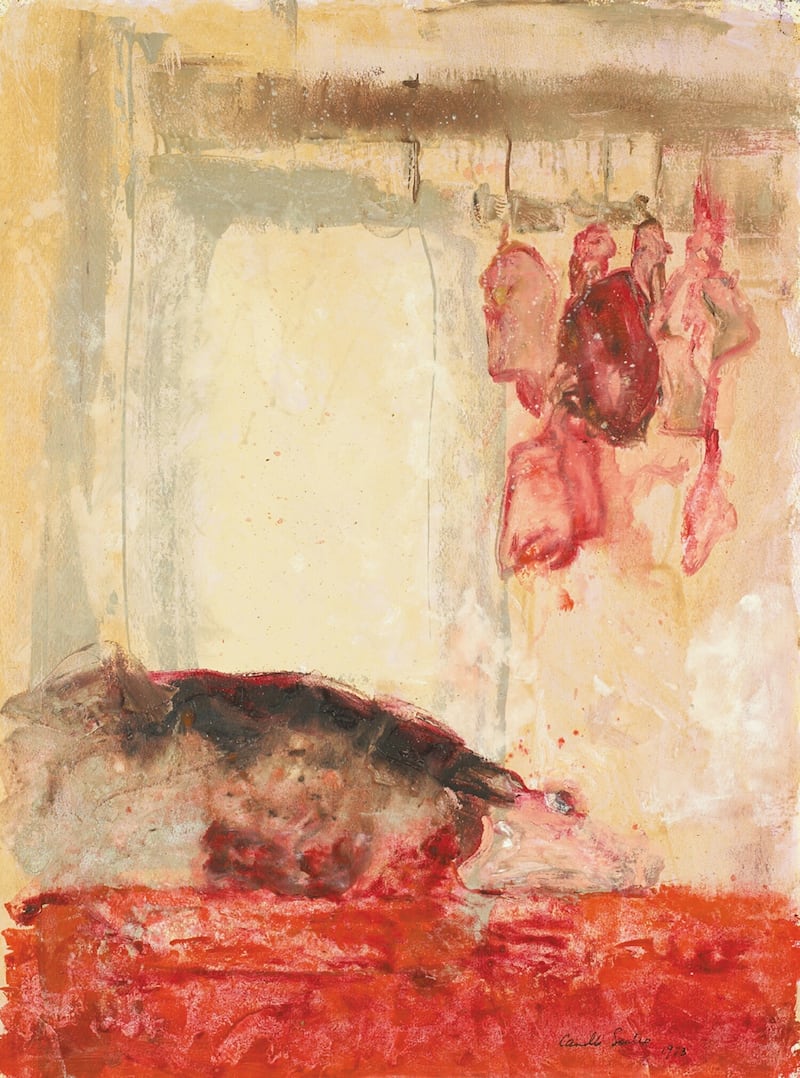Sometimes when great artists die we like to say they defined new movements and brought change so radical that things could never be the same again. Greatness, it seems, must come from destruction. And yet, while it’s true that it takes huge energy and vision to see how things might be completely different, it also takes both to see something more in what endures.
Camille Souter, who has died at the age of 93, did us all the great favour of looking more closely at small things and finding the richness within. They weren’t always small. After a period, like Mary Swanzy, almost 50 years her senior, Souter spent time exploring different painting styles, trying things on, so to speak, to see what fit.
Convalescing in Dublin from tuberculosis, Souter took up sculpture, and although she went on to complete her nursing studies, she chose to become an artist
Collages, with bright blocks of colour and thick black lines, painted over fragments of newspaper cuttings from the 1950s, show that she could do that stuff if she wanted to. But she could also make moments of reality transformative and mesmerising. Painting from chapters in her life, and dwelling on fascinations, Souter explored everything from circuses or her experiences of nursing to the incongruity of jet planes in the countryside, and from chunks of meat to glistening fish.
Born in Northampton in England in 1929, the then Betty Pamela Holmes was raised in Ireland. She went to Glengara Park School, in Dún Laoghaire, before returning to London to train as a nurse. Tuberculosis took her to a sanatorium on the Isle of Wight, where art therapy was part of the regime, alongside plenty of bracing air. TB was often a death sentence in those days, and the treatment could be brutal. Unsurprising, then, if it led to a change of path for its survivors. Convalescing in Dublin, Souter took up sculpture, and although she went on to complete her nursing studies, she chose to become an artist. Visiting Italy completed her informal art education.
READ MORE
Writing about her work in 1980, the art historian Anne Crookshank called Souter’s influences mainly European, including Jean Dubuffet, Antoni Tàpies and Paul Klee. Crookshank also noted something of the French postimpressionist Pierre Bonnard.
“Camille” was a nickname that stuck; it comes from the consumptive heroine of Alexandre Dumas’s novel La Dame aux Camélias. The Souter part comes from the artist’s first husband, the actor Gordon Souter. Despite these name changes, Souter remained firmly herself. People who worked with her, installing exhibitions, including her major retrospective at the Douglas Hyde Gallery in Dublin in 1980, remember her as lovely. She was also said to be very “sweet, and not a prima donna in any way”.
Does the art world give prizes for being sweet and nice? Not especially, and champions of her work hang on terms such as “statuesque” and “robust”. But such strength can come from gentleness. Souter was not seeking beauty in her work, but it is there. Neither was she seeking to swerve away from ugliness and death, but when she did paint hanging cuts of meat, a dead basking shark, or fish on a slab, you could see, for want of a better word, the humanity in it all. She also had a wit and intelligence that could undercut pretension and avoid the traps of sentimentality.

Souter didn’t give up abstraction entirely. It is more that she painted what she saw according to how it struck her. Calary Bog, from 1962, might seem almost purely abstract unless you have walked the raised road through the Wicklow landscape where Souter was living in a rambling and remote house at the time of her second marriage, to the sculptor Frank Morris. Remote suited her, and she is most closely associated with Achill, the Co Mayo island also famous as home for a time to the artist Paul Henry and the German writer Heinrich Böll.

It was in Wicklow that she got to know the art collector Basil Goulding, who became a great supporter, buying her work to the degree that visitors to his home remember stacks of her paintings, waiting for wall space to shine. All artists, especially those who don’t play art-world games, need good patrons, and in Goulding, as well as to a degree in the architect Michael Scott, Souter had that in spades. Her reputation rose, although Goulding would write in his notes to a 1961 exhibition that “it must be very rare for an artist to possess or attain to – and in this case they seem to coincide – powers of unfailing sensitivity as transmitted by techniques of unfailing discrimination – and all without much popular notice”.

Popular notice did follow, and four of her works were selected for The Irish Imagination 1959-1971, at the Hugh Lane gallery, which toured to Washington, DC. She received the Irish American Cultural Institute’s Gainey Award in 1975 and, later, the International Contemporary Art Prize awarded by the Prince Pierre Foundation, in Monaco. In 2008 she was elected a saoi of Aosdána, the highest accolade the Irish art world has to offer.
Those who met Souter, or knew her from photographs in her later years, will remember a small woman with greying hair under an ever-present black crochet beret. She may have seemed vague, as if living in the ideas of her next artwork, but her eyes were always sharp. Camille Souter’s life and career are worth celebrating, testaments to the greatness of exploring the small, the power of the calm, the towering strength it takes to live and create away from the currents of the fleeting popular, and so to make enduring art.



















